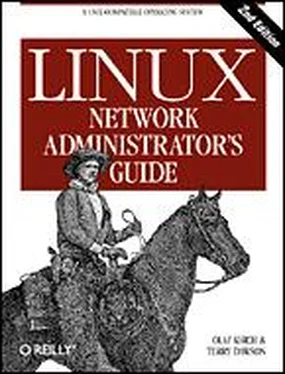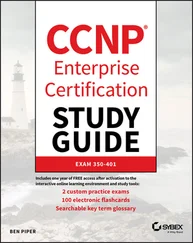Why, then, would you want to pay money for something you can get for free? Is Tim O'Reilly out of his mind for publishing something everyone can print and even sell themselves? [4] Note that while you are allowed to print out the online version, you may not run the O'Reilly book through a photocopier, much less sell any of its (hypothetical) copies.
Is there any difference between these versions?
The answers are "it depends," "no, definitely not," and "yes and no." O'Reilly& Associates does take a risk in publishing the Networking Guide, and it seems to have paid off for them (they've asked us to do it again). We believe this project serves as a fine example of how the free software world and companies can cooperate to produce something both can benefit from. In our view, the great service O'Reilly is providing to the Linux community (apart from the book becoming readily available in your local bookstore) is that it has helped Linux become recognized as something to be taken seriously: a viable and useful alternative to other commercial operating systems. It's a sad technical bookstore that doesn't have at least one shelf stacked with O'Reilly Linux books.
Why are they publishing it? They see it as their kind of book. It's what they'd hope to produce if they contracted with an author to write about Linux. The pace, level of detail, and style fit in well with their other offerings.
The point of the LDP license is to make sure no one gets shut out. Other people can print out copies of this book, and no one will blame you if you get one of these copies. But if you haven't gotten a chance to see the O'Reilly version, try to get to a bookstore or look at a friend's copy. We think you'll like what you see, and will want to buy it for yourself.
So what about the differences between the printed and online versions? Andy Oram has made great efforts at transforming our ramblings into something actually worth printing. (He has also reviewed a few other books produced by the Linux Documentation Project, contributing whatever professional skills he can to the Linux community.)
Since Andy started reviewing the Networking Guide and editing the copies sent to him, the book has improved vastly from its original form, and with every round of submission and feedback it improves again. The opportunity to take advantage of a professional editor's skill is one not to be wasted. In many ways, Andy's contribution has been as important as that of the authors. The same is also true of the copyeditors, who got the book into the shape you see now. All these edits have been fed back into the online version, so there is no difference in content.
Still, the O'Reilly version will be different. It will be professionally bound, and while you may go to the trouble to print the free version, it is unlikely that you will get the same quality result, and even then it is more unlikely that you'll do it for the price. Secondly, our amateurish attempts at illustration will have been replaced with nicely redone figures by O'Reilly's professional artists. Indexers have generated an improved index, which makes locating information in the book a much simpler process. If this book is something you intend to read from start to finish, you should consider reading the official printed version.
Chapter 1, Introduction to Networking, discusses the history of Linux and covers basic networking information on UUCP, TCP/IP, various protocols, hardware, and security. The next few chapters deal with configuring Linux for TCP/IP networking and running some major applications. We examine IP a little more closely in Chapter 2, Issues of TCP/IP Networking, before getting our hands dirty with file editing and the like. If you already know how IP routing works and how address resolution is performed, you can skip this chapter.
Chapter 3, Configuring the Networking Hardware, deals with very basic configuration issues, such as building a kernel and setting up your Ethernet card. The configuration of your serial ports is covered separately in Chapter 4, Configuring the Serial Hardware, because the discussion does not apply to TCP/IP networking only, but is also relevant for UUCP.
Chapter 5, Configuring TCP/IP Networking, helps you set up your machine for TCP/IP networking. It contains installation hints for standalone hosts with loopback enabled only, and hosts connected to an Ethernet. It also introduces you to a few useful tools you can use to test and debug your setup. Chapter 6, Name Service and Resolver Configuration, discusses how to configure hostname resolution and explains how to set up a name server.
Chapter 7, Serial Line IP, explains how to establish SLIP connections and gives a detailed reference for dip, a tool that allows you to automate most of the necessary steps. Chapter 8, The Point-to-Point Protocol, covers PPP and pppd, the PPP daemon.
Chapter 9, TCP/IP Firewall, extends our discussion on network security and describes the Linux TCP/IP firewall and its configuration tools: ipfwadm, ipchains, and iptables. IP firewalling provides a means of controlling who can access your network and hosts very precisely.
Chapter 10, IP Accounting, explains how to configure IP Accounting in Linux so you can keep track of how much traffic is going where and who is generating it.
Chapter 11, IP Masquerade and Network Address Translation, covers a feature of the Linux networking software called IP masquerade, which allows whole IP networks to connect to and use the Internet through a single IP address, hiding internal systems from outsiders in the process.
Chapter 12, Important Network Features, gives a short introduction to setting up some of the most important network applications, such as rlogin, ssh, etc. This chapter also covers how services are managed by the inetd superuser, and how you may restrict certain security-relevant services to a set of trusted hosts.
Chapter 13, The Network Information System, and Chapter 14, The Network File System, discuss NIS and NFS. NIS is a tool used to distribute administative information, such as user passwords in a local area network. NFS allows you to share filesystems between several hosts in your network.
In Chapter 15, IPX and the NCP Filesystem, we discuss the IPX protocol and the NCP filesystem. These allow Linux to be integrated into a Novell NetWare environment, sharing files and printers with non-Linux machines.
Chapter 16, Managing Taylor UUCP, gives you an extensive introduction to the administration of Taylor UUCP, a free implementation of the UUCP suite.
The remainder of the book is taken up by a detailed tour of electronic mail and Usenet news. Chapter 17, Electronic Mail, introduces you to the central concepts of electronic mail, like what a mail address looks like, and how the mail handling system manages to get your message to the recipient.
Chapter 18, Sendmail, and Chapter 19, Getting Exim Up and Running, cover the configuration of sendmail and exim, two mail transport agents you can use for Linux. This book explains both of them, because exim is easier to install for the beginner, while sendmail provides support for UUCP.
Chapter 20, Netnews, through Chapter 23, Internet News, explain the way news is managed in Usenet and how you install and use C News, nntpd, and INN: three popular software packages for managing Usenet news. After the brief introduction in Chapter 20, you can read Chapter 21, C News, if you want to transfer news using C News, a traditional service generally used with UUCP. The following chapters discuss more modern alternatives to C News that use the Internet-based protocol NNTP (Network News Transfer Protocol). Chapter 22, NNTP and the nntpd Daemon covers how to set up a simple NNTP daemon, nntpd, to provide news reading access for a local network, while Chapter 23 describes a more robust server for more extensive NetNews transfers, the InterNet News daemon (INN). And finally, Chapter 24, Newsreader Configuration, shows you how to configure and maintain various newsreaders.
Читать дальше



![Andrew Radford - Linguistics An Introduction [Second Edition]](/books/397851/andrew-radford-linguistics-an-introduction-second-thumb.webp)








